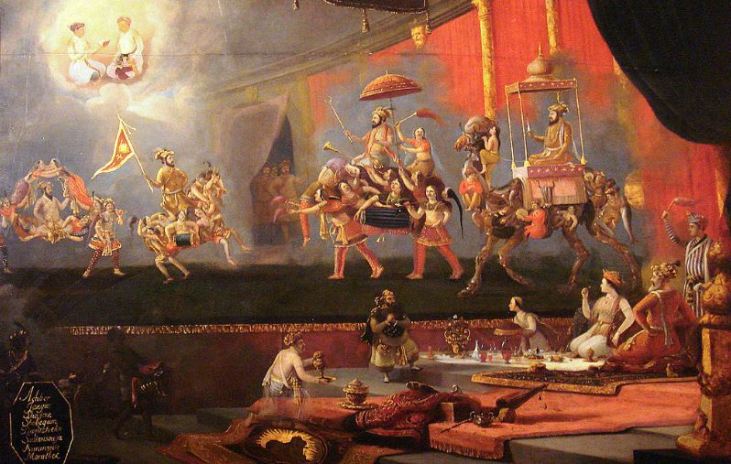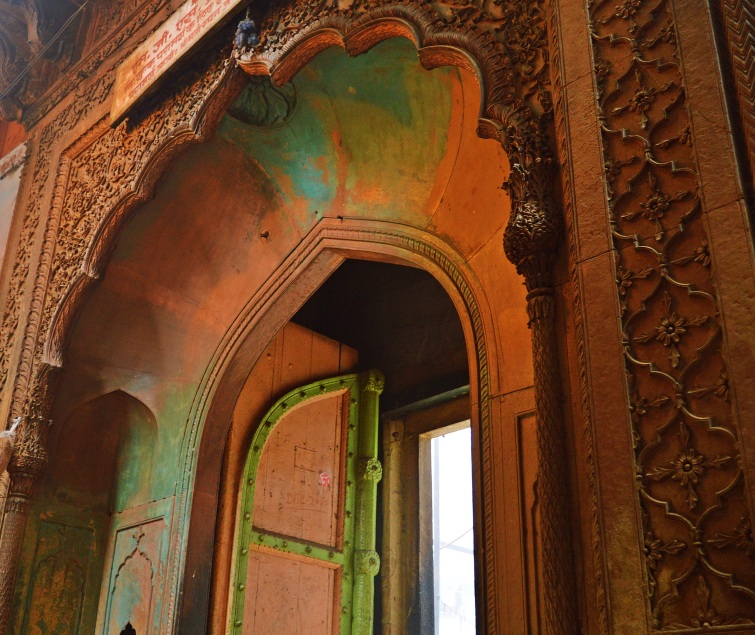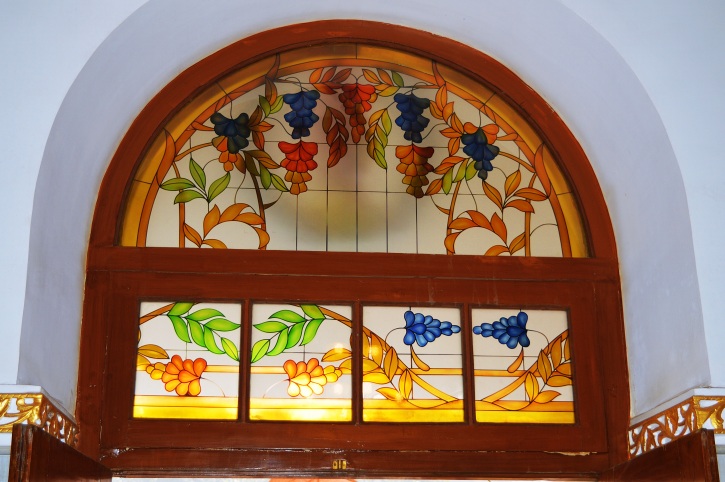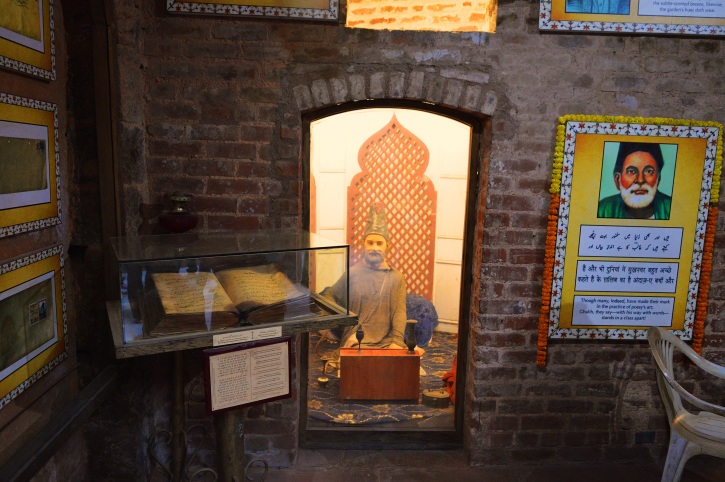Where dwelt only the loved ones of fate,
Which has now been ruined by the hands of Time,
I’m a resident of that storm-tossed place..”
After the death of his 38-year old beloved wife Mumtaz – …“the chosen one of the palace” & mother to 14 children , Shah Jahan – corroded with grief – kept himself busy in his grand building schemes, beginning with the Taj Mahal, described by Rabindranath Tagore as “a teardrop on the cheek of time.” Then, perhaps, to escape the searing heat of Agra, and may be from the memories of Mumtaz, he chose to shift his capital from Agra to Delhi & built a new metropolis Shahjahanabad in 1648 on the western banks of river Yamuna. In the heart of city, he erected the Red fort: designed by Ustad Ahmadi Lahori & superintended by the Persian Mukamat Khan : the defining monument of Shahjahanabad, like the Acropolis is to Athens; where inside, past the delicate jharokas, down the Naqqar Khana ‘ the house of drums’ followed by an enclosed courtyard , it led to the 40-pillared Diwan-I-Am; where the Emperor controlled the heart-beat of the Mughal empire, sitting on his Peacock throne, made from 1150 kg of gold and supported with 12 emerald columns, and aglitter with emeralds, rubies, diamonds and pearls. The private quarters or the zenana –where the ladies were cocooned by a hierarchy of female spies, watchful eunuchs and muscular female Uzbek guards; and entertained by troupes of dancing girls, mimics and acrobats -was nestled within cool scented water flowing down bubbling water ways, fountains, pools and fragrant trees and paradise gardens. Chandni Chowk-the Moonlit Bazaar- was designed by Jahanara herself, the favorite daughter of Shah Jahan. The square shaped bazaar enclosed a central pool, and the market area divided by water canals, to reflect the moonlight. As per the 17th century writer Chandar Bhan Brahman ‘the city is like Garden of Eden, its lanes are like the roads of Paradise. It is like the foundation of the eighth heaven, the center of great circle of Islam.’
Delhi however lived upto its reputation of slipping through the very fingers of those who attempted to raise a new city here: starting from Prithvi Raj Chauhan’s Lal Kot; from Allauddin Khilji’s Siri; from the Tughluq trio’s troika of Tughluqabad, Jahanpanah & Kotla Firuz Shah; Humayun’s Dinapanah & later the Lutyens Delhi of the British; Shah Jahan’s majestic offering to the city of his choice would soon be destroyed by fate. Not more than mere 9 years of rule by Shah Jahan must have passed, considered as the golden period of Mughal rule; when the cold blooded animosity amongst his children – a rebound of the ‘takht ya takhta’ precedence Shah Jahan himself had set for securing the throne by murdering his brothers- saw not only his ouster but also the beginning of the city’s gradual downfall. The absence of Mumtaz’s motherly empathy in the family accentuated the differences among her children, and as the Emperor’s favoritism and rumored lust for his daughter Jahanara infuriated his other daughter Roshanara with jealousy ; just like his open declaration of son Dara Shukoh as his preferred successor, made his younger son Aurangzeb rise in an open military revolt against his father. Killing his siblings who opposed him and poisoning to death those who supported him, imprisoning his father, and sending the cleaned severed head of his brother Dara in a gift box to Shah Jahan to be opened to him at his lunch time as a present to a forgiving father; Aurangzeb’s rise to the throne and his subsequent focus on the faraway Deccan, saw the beginning of a gradual downfall of Shahjahanabad from 1657.
Exactly 200 years later, after quelling the 1857 uprising , the British planned a complete demolition of the city : however if there was Londoner Lord Palmerstone supported by the Lahore Chronicle, and the Delhi Commissioner Saunders who convinced Lord Canning to delete Delhi entirely from the map, then there was another British John Lawrence who was successful in counter-convincing Lord Canning to scale back the destructions; though it was sufficiently late for the mass arrests, assassinations and slaughters : the Muslims of the city were driven out to live like gypsies, the male descendants of the King were eligible to a monthly pension of a mere Rs 5 – the female descendants: if old reduced to bawds & if young, to prostitutes. Ghalib wrote of the ladies of the Fort, “ their faces as fair as the moon moving around the city with their dirty and torn clothes, slippers falling to pieces”. Ghalib wondered if there is any point of carrying on when everything he had lived for has been destroyed “ Four things kept Delhi alive : the Fort, the daily crowds at Jama Masjid, weekly walk to the Yamuna bank, and yearly fair of the flower-men : None of these survives today”. The Lal Qila was turned into a grey British barrack: its delicate Diwan-I-Am, Rang Mahal, Mumtaz Mahal, and its pavilions of Hayat Baksh Bagh ; were turned into an officers’ lounge, a mess, a prison hall and an urinal – in that order. The center of learning in the whole of Islamic world was ripped apart : its madrasas and libraries ransacked and auctioned off – the most famous of them, Madrasa-i-Rajimiya was reduced to a store-house. The fabled madrasas of Delhi- the celebrated intellectual centres: teaching in Arabic and Persian, and producing students who confidently discussed about Sokrat (Socrates), Aristotalis (Aristotle), and Alflatun (Plato): were all razed to ground.
In Ghalib’s words:
“We smashed the wine cup and the flask;
What is it now to us
If all the rain that falls from heaven
Should turn to rose-red wine?”
It is said that the British demolished almost 80% of Shahjahanabad in a fit of vengeance in 1857; but it took the mass caravan of 1947 partition to completely alter the soul and character of the city. The coherent culture, brought forth and practiced by the Hindus & Muslims alike for hundreds of years, was suddenly stopped by a group of people who forbade the inter mingling of the Hindus and Muslims.. The unprecedented Muslim exodus from the city to Karachi and Lahore was matched only by the swelling mass of Punjabis incoming from the opposite direction; the city turned into a refugee town of white tents, its population rising from 9L in 1941 to 18L in 1951, the burnt out and ransacked havelis of the Shahjahanabad then occupied by the migrant Punjabis.
Even those Muslim scholars, like Ahmed Ali – writer of ‘A Twilight in Delhi’ who never had any interest in Pakistan, – and was visiting Nanking University in China at the time of partition -, was not allowed to return to India. He was forced to proceed directly to Pakistan, where, he laments, “they never accepted me in Pakistan.” The decision to chose a new country and leave behind their beloved city was never voluntary: the city of Sultans and Sufis, of Poets and Philosophers; the city of Khalifas and their fighting birds, the city of powerful Khwaja Saras or the eunuchs who had preferable access to all the Kings’ Zenanas; the city where generations were being groomed as per the strict guidelines of Mirza Nama, or the ‘Book of the Perfect Gentleman’.
Over the years, the old timers of the city, brought up in the Mushairas and Mehfils of the old Mughal culture, saw the incoming Punjabis as hardworking but uncultivated nouveau riche public show-offs having no cultural belongingness ; whereas the Punjabis considered the old inhabitants they were replacing as lazy, un-ambitious and good-for-nothing. The schism and the mutual feeling of alienation and estrangement continued as an un-repairable gift of the parting British.
Finally, with the migrant population moving to newer areas of Delhi; Shahjahanabad was forever condemned as the neglected store house of wholesale made-in-China goods; a ghetto looked down by the prosperous middle class. In those days, if the “exiled intelligentsia” would huddle in a Karachi drawing room to recall the times reminiscent of the old city they had left behind, the city of nautch girls and fine dining, the city of airy havelis with intricate wood carved roofs and stone work, miniature mosques and libraries; its men and manners, its literature and language; nothing would have been farther from the stark reality. The havelis and mosques all gone, the poet laureate Zauq’s tomb was lost under a public urinal, hotels sprung up on tombs of noblemen; and the pauper poet Ghalib’s rented haveli turned into a coal depot and a a marriage hall.. until very recently.
As the last Emperors Zafar would capture the feeling:
“I’m the light of no one’s eye,
The rest of no one’s heart am I,
That which can be of no use to none,
-Just a handful of dust am I.”
The 17th century art work by Dutch painter Willem Schellinks showing Shahjahan and daughter Jahanara watching a parade of his four sons- Dara, Aurangzeb, Shah Shuza, and Murad on composite animals while Akbar & Jahangir look down from the heavenly clouds.
While designing the city, Shah Jahan invited the Agarwal community to settle in his new city and also granted them land to build a Jain temple. The temple, re-built many a times, was initially without a Shikhara as it was not allowed to have a temple with Shikhara within the walled city. The main deity of the temple is Mahavira , born in 599BC in the ancient kingdom of Vaishali. The marble idols are believed to date back to 1491 commissioned by Jivaraj Papriwal, who was a 15th century Rajasthani trader employing an army of craftsmen to carve and install numerous Jain statues, after the destruction of temples and idols by invaders
The bird hospital inside the Jain Temple.
The Shiv Mandir was erected by a Maratha soldier Apa Ganga Dhar in 1761 who had prayed to God to build a beautiful temple, if he survives a fatal injury sustained in a battle. The temple has a 800 year old brown Shivalinga.
Site of execution of Guru Tegh Bahadur’s three disciples were executed by Aurangzeb.
The Fountain Chowk , earlier called Northbrook Fountain, after Viceroy Lord Northbrook(1872-76) who donated money for its construction; was also called Bhai Mati Das Chowk, named after Guru Tegh Bahadur’s disciple who was sawn into half, lengthwise, at this site.
The Khazanchi gali was populated by the accountants of the Mughal court. A tunnel once connected the haveli to the Red fort for safe transport of money. The 800 year old haveli is now in ruins thanks to people still claiming ownership to these type of heritage buildings and resorting in design alterations over the time
The Central Baptist Church, considered as the oldest Church in the whole of North India, was established in 1814 to propagate Christianity when Baptist Missionary Society of London purchased the land. Its rich English architectural feel is accentuated by the intricate carvings, round pillars, and white walls containing tablets with names of the faithfuls.
A restored façade of Begum Samroo Palace with its cheap-looking glass panels, covering just one part of the huge complex that houses the electronics wholesale bazaar , people haggling over made-in China LED lights where not very long ago, fine dining to the Mughal nobles were being hosted.
Compared to Ahilya Bai of Indore; Begum Samru had a humble beginning. Rescued and groomed by Khanum Jan ,the… legendary tawaif of Chauri Bazar, Farzana became one of the most sought after girls of her Kothi. Soon, in 1765 the Austrian Reinhardt, providing paid military mercenary service to different Indian states, whisked Farzana from Khanum Jan’s kotha when she was just 15. Reinhardt who changed his name as Sommers, or sometimes referred as Sombre for his looks, and Indianized as Samru; was a hunted man by the British for his murder of 150 British civilians in Patna; and always was on the run with his partner Farzana gaining military insights. When Reinhardt helped the Mughal emperor Shah Alam to defeat Jats in 1773, he was awarded the village of Sardhana near Meerut. Five years later in 1778 , with the death of Reinhardt, Ferzana or Begum Samru – barely 28 years old, took over the reigns of the Sardhana principality that was yielding 90K pounds per year. When the Rohillas attacked Delhi in 1788 and blinded Shah Alam, it was Begum Samroo who drove out the Rohillas and restored the Emperor to his empire; for which she was awarded Zebun Nissa, ‘Ornament of Women’. She was again honored as “his most beloved daughter” for her continued military assistance, and was awarded Badshahpur Jharsa village in Gurgaon. She was also successful in persuading a Sikh army of 30,000 encamped at a place now known by that event as Tis Hazari, to retreat from their attack on Shah Alam.
The dilapidated part of the Palace with a huge drive way in front, now of course, seem un-imaginable in the shabby neighborhood.
After Reinhardt’s death in 1778, Begum Samroo converted to Christianity and changed her name to Joanna. In 1790, she fell in love with Feenchman Vassoult that proved to be her waterloo. In an imminent capture, Begum & Vassoult agreed on a suicide pact, where the Begum somehow survived. It was only with the help of George Thomas that she was successfully rescued and Sardhana was restored to her. In the British-Maratha wars, she could not decide her mind, but finally switched to the British side.
Begum Samroo, dressed in Mughal attires with her huqqa in her hand, conducted her business while promoting Christianity in an astonishing example of feminism and religious freedom. In the battle field, riding her horse and wearing a turban, she annihilated her opponents and her gallantly, presence of mind and fearlessness earned her a reputation of a witch who could vanquish any enemy.
Her palatial Chandni Chowk palace built in a garden was gifted to her by Mughal emperor Akbar Shah after Shah Alam’s death. She died in 1835, leaving her vast fortune to Reinhardt’s son, the wonderfully named step-son David Ochterlony Dyce Sombre.
Talking of Queen Victoria, it was a letter to her Highness that played an important role in the life of Mirza Ghalib. Ghalib’s letter to the Queen praising her “as splendid as stars”, “as magnificent as Alexander” and requesting her to approve him a title and a monthly pension, did not materialize in getting his wishlist; but definitely saved his life afterwards.
When the mass assassinations by trigger happy British troops was in full swing, Ghalib was called up by Col Burns for interrogation. Putting up his best Turkish headgear, Ghalib presented himself for the interview to face the Colonel’s remark: “You Muslim? “ Ghalib, unperturbed, replied, “ Only Half: I drink wine, but I don’t eat pork”; and presented proof of his letter to Queen Victoria that he had penned earlier. The Colonel let him go. Ghalib was , in fact, only one of the Mughal court elites to have survived this mass-purge; with his property intact in his Ballimaran mohalla. However, his life’s greatest achievement – the collection of his verses, was lost forever.
Ballimaran, or Billi-maran ‘the Cat-killers street’, was populated by Unani hakims and noble elites in the 1640’s when the city was built. Back then, it was one of the aristocratic addresses with large airy havelis.
Right on the stump of the city gate that Nadir Shah destroyed, now sits this sweet-shop, at the beginning of the Dariba Kalan – the Jewellers’ Lane. It dates back to Shah Jahan’s times; and derives its name from Persian ‘Dur-e be-baha’- unparalleled pearl; and was the target of Nadir Shah’s attack. It is said the kiling by Nadir Shah in 1739 finally stopped when one petitioner came in front of Nadir Shah to recite :
None is left now for you to kill with your coquettish sword,
Unless you bring them back to life and then kill again.
———————————————————
This walk was led by Sohail Hashmi of ‘Delhi Heritage Walks with Sohail Hashmi’
References:
- City of Djinns ; by William Dalrymple
- The Last Mughal; by William Dalrymple
- A Teardrop on the Cheek of Time; by Diana Preston
- A Twilight in Delhi; by Ahmed Ali
- http://ikashmir.net/kuldeepraina/samru.html































Nice blog sir! I am sure you’ll beautify this piece of art further with time…eagerly tuned in for more 🙂 Best wishes!
LikeLiked by 1 person
Thanks Aditya for motivating me into the world of blogging.. definitely will try to further polish the page layout.
LikeLike
good luck 🙂
LikeLiked by 1 person
Beautiful Dada … Zafar ka Sher was like icing on the cake !!!
” Is nazaakat ka bura ho, vo bhale hain to kya ,
Haath aain to unhe haath laagte na baane ”
Add some more couplets to attract people of my clan …
All the best !!!
LikeLike
Thanks Somendra ji for sharing the couplet.. your inputs will always be in demand here !
LikeLike
EXCELLENT !!!
LikeLiked by 1 person
Good writing Deb babu – never knew this hidden gem inside you. Cheers
LikeLiked by 1 person
Great post. You have beautifully tried to capture the soul of old Delhi.
LikeLike
very nice information…..great
LikeLike